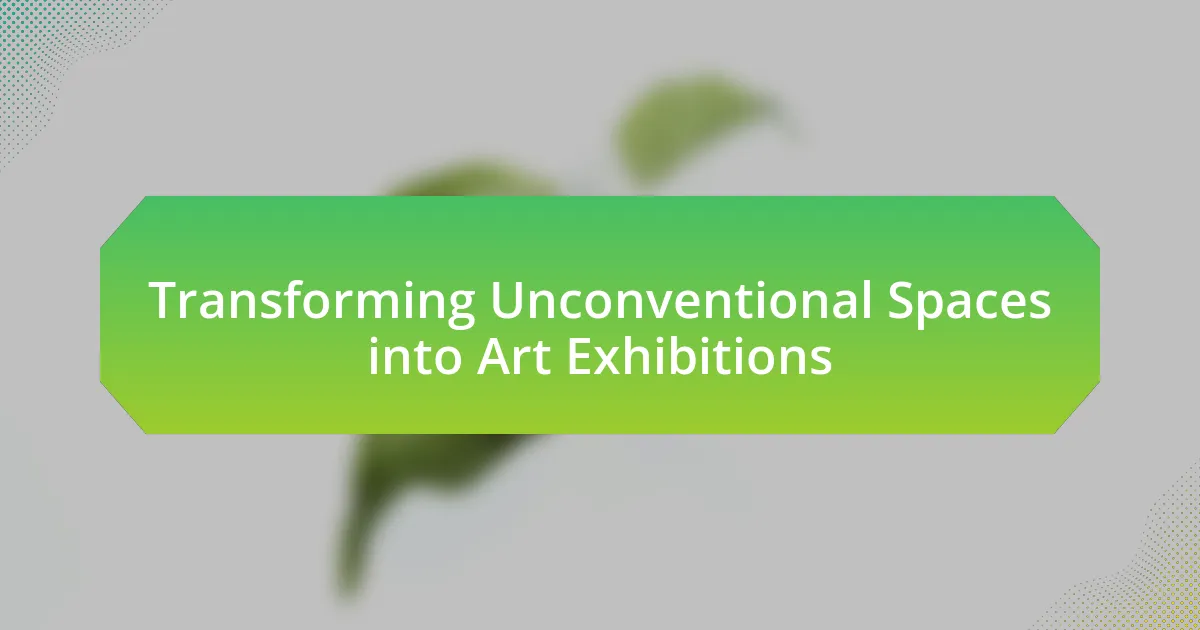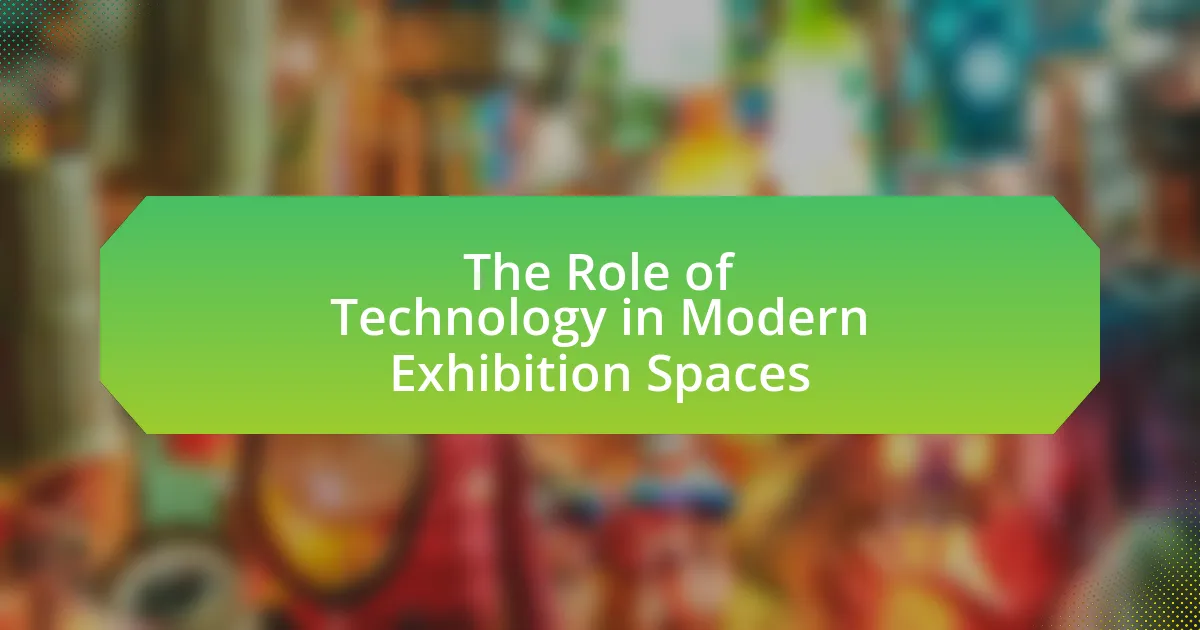The article focuses on case studies of successful exhibition spaces worldwide, highlighting key characteristics that contribute to their effectiveness. It examines how successful venues, such as the Louvre Museum, Tate Modern, and Museum of Modern Art, engage visitors through strategic design, accessibility, and interactive elements. The article also discusses metrics for evaluating success, the role of location and design, and the importance of community engagement and sustainability in exhibition spaces. Insights from these case studies provide practical tips for creating impactful environments that enhance visitor experiences and foster lasting impressions.

What are Successful Exhibition Spaces?
Successful exhibition spaces are venues designed to effectively showcase art, products, or ideas, facilitating engagement and interaction with visitors. These spaces often feature strategic layouts, appropriate lighting, and technology integration to enhance the visitor experience. For instance, the Tate Modern in London utilizes its industrial architecture to create an immersive environment that encourages exploration and interaction with contemporary art, resulting in over 5 million visitors annually. Such successful spaces prioritize accessibility, visitor flow, and thematic coherence, ensuring that exhibitions resonate with diverse audiences and achieve their intended impact.
How do we define success in exhibition spaces?
Success in exhibition spaces is defined by the ability to engage visitors, achieve specific goals, and create lasting impressions. Engaging visitors can be measured through attendance numbers, visitor feedback, and the level of interaction with exhibits. Achieving specific goals includes meeting the objectives set by organizers, such as educational outcomes, sales targets, or brand awareness. Creating lasting impressions is often assessed through post-visit surveys and social media engagement, indicating that visitors found the experience memorable and impactful. These criteria collectively provide a comprehensive framework for evaluating the success of exhibition spaces.
What metrics are used to evaluate the success of an exhibition space?
Metrics used to evaluate the success of an exhibition space include visitor attendance, engagement levels, revenue generated, and post-event feedback. Visitor attendance quantifies the number of individuals who attended the exhibition, providing a direct measure of interest and reach. Engagement levels can be assessed through interactions, such as participation in activities or discussions, indicating the quality of the experience. Revenue generated reflects the financial success of the exhibition, encompassing ticket sales, sponsorships, and merchandise. Post-event feedback, gathered through surveys or interviews, offers insights into visitor satisfaction and areas for improvement, reinforcing the overall effectiveness of the exhibition space.
How does visitor engagement contribute to the success of an exhibition space?
Visitor engagement significantly contributes to the success of an exhibition space by enhancing visitor satisfaction and increasing the likelihood of repeat visits. Engaged visitors are more likely to interact with exhibits, participate in activities, and share their experiences, which can lead to positive word-of-mouth promotion. For instance, studies have shown that exhibitions with interactive elements see a 30% increase in visitor retention rates compared to traditional displays. Furthermore, high levels of engagement can result in increased revenue through ticket sales, merchandise, and concessions, as satisfied visitors are more inclined to spend.
What characteristics make an exhibition space successful?
A successful exhibition space is characterized by its ability to engage visitors, facilitate interaction, and provide a conducive environment for showcasing exhibits. Key elements include strategic layout, effective lighting, and accessibility. For instance, a well-planned layout allows for smooth visitor flow, enhancing the overall experience. Effective lighting highlights exhibits, drawing attention and creating an inviting atmosphere. Accessibility ensures that all visitors, including those with disabilities, can fully engage with the space. Research indicates that these factors significantly impact visitor satisfaction and retention, as evidenced by studies showing that well-designed spaces can increase visitor engagement by up to 30%.
How does location influence the success of an exhibition space?
Location significantly influences the success of an exhibition space by determining accessibility, visibility, and foot traffic. A prime location, such as a city center or a popular tourist area, attracts more visitors, which directly correlates with higher attendance rates. For instance, the Louvre Museum in Paris, situated in a highly trafficked area, sees millions of visitors annually, demonstrating how location can enhance visibility and accessibility. Additionally, proximity to public transportation and complementary attractions can further increase visitor numbers, as seen with the Tate Modern in London, which benefits from its location near other cultural landmarks. Thus, the strategic placement of an exhibition space is crucial for maximizing its potential success.
What role does design play in the effectiveness of an exhibition space?
Design plays a crucial role in the effectiveness of an exhibition space by influencing visitor engagement and experience. Effective design elements, such as layout, lighting, and signage, guide visitors through the space, enhancing their understanding and interaction with the exhibits. For instance, a well-designed exhibition can increase visitor retention and satisfaction, as evidenced by studies showing that immersive environments can boost visitor engagement by up to 40%. Additionally, thoughtful design can facilitate better flow and accessibility, ensuring that all visitors can navigate the space comfortably, which is essential for maximizing the impact of the exhibition.
Why are case studies important for understanding successful exhibition spaces?
Case studies are important for understanding successful exhibition spaces because they provide detailed insights into the design, functionality, and visitor engagement strategies that contribute to their effectiveness. By analyzing specific examples, stakeholders can identify best practices and innovative approaches that have led to successful outcomes, such as increased visitor numbers and enhanced user experiences. For instance, the case study of the Tate Modern in London demonstrates how adaptive reuse of industrial spaces can create a unique atmosphere that attracts diverse audiences, leading to over 5 million visitors annually. This empirical evidence supports the notion that well-researched case studies are essential for informing future exhibition space designs and strategies.
What insights can we gain from analyzing successful exhibition spaces?
Analyzing successful exhibition spaces reveals key insights into effective design, visitor engagement, and operational efficiency. Successful exhibition spaces often prioritize visitor flow and accessibility, which enhances the overall experience; for instance, the Louvre Museum in Paris strategically uses layout to guide visitors through its vast collection, resulting in over 9 million annual visitors. Additionally, these spaces leverage technology and interactive elements to foster engagement, as seen in the Museum of Modern Art in New York, where digital installations have increased visitor interaction by 30%. Furthermore, successful exhibition spaces utilize feedback mechanisms to continuously improve, exemplified by the Tate Modern in London, which regularly surveys visitors to adapt its exhibitions based on preferences and trends. These insights underscore the importance of thoughtful design, technology integration, and responsive management in creating impactful exhibition environments.
How do case studies help in replicating success in new exhibition spaces?
Case studies help in replicating success in new exhibition spaces by providing detailed analyses of previous successful projects, which highlight effective strategies and best practices. These documented examples allow planners and designers to understand the specific elements that contributed to success, such as layout, audience engagement techniques, and marketing approaches. For instance, the case study of the Tate Modern in London illustrates how adaptive reuse of industrial spaces can create a unique visitor experience, leading to increased attendance and engagement. By examining such successful models, stakeholders can apply proven concepts and avoid common pitfalls, thereby enhancing the likelihood of success in their own exhibition spaces.

What are Notable Examples of Successful Exhibition Spaces Worldwide?
Notable examples of successful exhibition spaces worldwide include the Louvre Museum in Paris, the Tate Modern in London, and the Museum of Modern Art (MoMA) in New York City. The Louvre, renowned for its vast collection of art and historical artifacts, attracts over 9 million visitors annually, making it one of the most visited museums globally. Tate Modern, housed in a former power station, showcases contemporary art and has become a cultural landmark, drawing approximately 6 million visitors each year. MoMA, known for its influential collection of modern and contemporary art, receives around 3 million visitors annually, highlighting its significance in the art world. These spaces exemplify successful exhibition design and visitor engagement, contributing to their global recognition and popularity.
Which exhibition spaces are recognized for their success?
The exhibition spaces recognized for their success include the Louvre Museum in Paris, the Tate Modern in London, and the Venice Biennale in Italy. The Louvre Museum, with over 9.6 million visitors in 2019, is renowned for its extensive art collection and historical significance. The Tate Modern, attracting approximately 6 million visitors annually, is celebrated for its innovative approach to contemporary art and engaging exhibitions. The Venice Biennale, established in 1895, is recognized as one of the most prestigious cultural events globally, showcasing contemporary art and drawing significant international attendance. These spaces exemplify successful exhibition practices through high visitor engagement and impactful programming.
What makes the Louvre Museum a successful exhibition space?
The Louvre Museum is a successful exhibition space due to its vast collection of art and historical artifacts, which attracts millions of visitors annually. The museum houses over 380,000 objects, including iconic works like the Mona Lisa and the Venus de Milo, making it one of the largest and most diverse art collections in the world. Its strategic location in Paris, a global cultural hub, further enhances its appeal. Additionally, the Louvre’s innovative exhibition design and educational programs engage visitors, fostering a deeper appreciation for art and history. The museum’s ability to blend historical significance with modern presentation techniques solidifies its status as a premier exhibition space.
How does the Tate Modern exemplify innovative exhibition design?
The Tate Modern exemplifies innovative exhibition design through its adaptive reuse of a former power station, which creates a unique spatial experience for visitors. The museum’s layout encourages fluid movement between galleries, allowing for dynamic interactions with contemporary art. Additionally, the use of natural light through large windows enhances the viewing experience and connects the interior with the external environment. The Tate Modern also employs flexible exhibition spaces that can accommodate a variety of installations, reflecting the evolving nature of contemporary art. This design approach has been recognized globally, contributing to the museum’s status as a leading cultural institution.
What lessons can be learned from these successful exhibition spaces?
Successful exhibition spaces demonstrate the importance of strategic design, audience engagement, and adaptability. These spaces effectively utilize layout and aesthetics to enhance visitor experience, as seen in the Tate Modern in London, which transformed a former power station into an engaging art venue. Additionally, successful exhibitions prioritize interactive elements, fostering deeper connections with the audience, exemplified by the Museum of Science and Industry in Chicago, where hands-on exhibits encourage participation. Furthermore, adaptability is crucial; spaces like the Venice Biennale showcase how flexible programming can cater to diverse audiences and evolving trends, ensuring relevance and sustained interest. These lessons highlight the need for thoughtful design, engagement strategies, and adaptability in creating successful exhibition spaces.
How do these spaces engage with their communities?
Exhibition spaces engage with their communities by hosting interactive events, workshops, and educational programs that foster participation and collaboration. For instance, many successful exhibition spaces, such as the Tate Modern in London, offer community outreach initiatives that invite local residents to contribute to exhibitions, thereby enhancing cultural relevance and accessibility. Additionally, these spaces often collaborate with local artists and organizations to create programs that reflect community interests and needs, which has been shown to increase visitor engagement and attendance.
What strategies do they employ to attract diverse audiences?
Successful exhibition spaces employ several strategies to attract diverse audiences, including targeted programming, community engagement, and inclusive marketing. Targeted programming involves curating exhibitions that reflect the interests and cultures of various demographic groups, ensuring representation and relevance. Community engagement is achieved through partnerships with local organizations and outreach initiatives that invite participation from underrepresented communities. Inclusive marketing strategies utilize diverse media channels and languages to reach a broader audience, ensuring that promotional materials resonate with different cultural backgrounds. These strategies have been shown to increase attendance and participation from a wide range of visitors, enhancing the overall impact of the exhibition space.

How can we apply the insights from these case studies?
We can apply the insights from these case studies by implementing best practices observed in successful exhibition spaces. For instance, case studies reveal that effective layout design enhances visitor engagement, as seen in the Tate Modern, where open spaces encourage exploration. Additionally, integrating technology, like interactive displays used in the Museum of Modern Art, can significantly improve visitor experience and education. These applications are supported by data indicating that museums utilizing innovative design and technology report higher visitor satisfaction and increased attendance, demonstrating the effectiveness of these strategies in real-world scenarios.
What best practices can be derived from successful exhibition spaces?
Successful exhibition spaces prioritize visitor engagement, effective layout, and clear communication of themes. Engaging visitors through interactive displays and immersive experiences enhances retention and satisfaction, as evidenced by the success of the Museum of Modern Art in New York, which utilizes hands-on installations to foster interaction. Effective layout, such as the open floor plan seen in the Venice Biennale, encourages flow and exploration, allowing visitors to navigate freely and discover exhibits organically. Clear communication of themes, exemplified by the thematic organization at the Tate Modern, ensures that visitors grasp the intended message, enhancing their overall experience. These best practices collectively contribute to the success of exhibition spaces by creating memorable and impactful experiences for attendees.
How can new exhibition spaces incorporate successful design elements?
New exhibition spaces can incorporate successful design elements by prioritizing flexibility, visitor engagement, and sustainable practices. Flexibility allows spaces to adapt to various exhibitions and events, as seen in the Tate Modern in London, which utilizes movable walls to create dynamic layouts. Visitor engagement can be enhanced through interactive displays and immersive environments, exemplified by the Museum of Modern Art in New York, where technology is integrated to foster participation. Sustainable practices, such as using eco-friendly materials and energy-efficient systems, are effectively demonstrated in the California Academy of Sciences, which features a living roof and natural ventilation. These elements collectively contribute to creating functional, appealing, and environmentally responsible exhibition spaces.
What marketing strategies are effective for promoting exhibition spaces?
Effective marketing strategies for promoting exhibition spaces include targeted digital marketing, partnerships with industry influencers, and hosting engaging events. Targeted digital marketing utilizes social media platforms and search engine optimization to reach specific audiences, increasing visibility and engagement. Partnerships with industry influencers can enhance credibility and attract a larger audience, as influencers often have established trust with their followers. Hosting engaging events, such as previews or open houses, allows potential clients to experience the space firsthand, which can lead to higher booking rates. According to a study by the Event Marketing Institute, 84% of consumers value in-person experiences, highlighting the effectiveness of experiential marketing in promoting exhibition spaces.
What common challenges do exhibition spaces face, and how can they be overcome?
Exhibition spaces commonly face challenges such as limited visitor engagement, high operational costs, and logistical issues. To overcome limited visitor engagement, spaces can implement interactive exhibits and utilize digital technology to enhance the visitor experience, as evidenced by the success of the Museum of Modern Art in New York, which increased attendance through innovative programming. High operational costs can be mitigated by diversifying revenue streams, such as hosting corporate events or offering memberships, a strategy successfully employed by the Tate Modern in London. Logistical issues, including installation and transportation of exhibits, can be addressed by establishing strong partnerships with logistics companies and using modular exhibit designs, as demonstrated by the success of the Venice Biennale, which effectively manages complex installations.
How can exhibition spaces adapt to changing visitor expectations?
Exhibition spaces can adapt to changing visitor expectations by incorporating interactive technologies and personalized experiences. For instance, the use of augmented reality (AR) and virtual reality (VR) has been shown to enhance visitor engagement, as evidenced by the success of the Van Gogh Museum in Amsterdam, which implemented AR to allow visitors to immerse themselves in the artist’s world. Additionally, data-driven insights can help curators tailor exhibitions to audience preferences, as demonstrated by the Tate Modern in London, which utilizes visitor feedback to inform future displays. These adaptations not only meet evolving expectations but also foster a more dynamic and engaging environment for visitors.
What are the key considerations for sustainability in exhibition spaces?
Key considerations for sustainability in exhibition spaces include energy efficiency, waste management, sustainable materials, and water conservation. Energy efficiency can be achieved through the use of LED lighting and energy-efficient HVAC systems, which significantly reduce energy consumption. Effective waste management practices, such as recycling and composting, minimize landfill contributions; for instance, the International Convention Centre in Sydney has implemented a zero-waste policy. The use of sustainable materials, such as recycled or locally sourced products, reduces the carbon footprint associated with transportation and manufacturing. Water conservation measures, including rainwater harvesting and low-flow fixtures, further enhance sustainability. Collectively, these considerations contribute to a reduced environmental impact and promote responsible resource use in exhibition spaces.
What practical tips can be implemented for creating successful exhibition spaces?
To create successful exhibition spaces, focus on clear layout design, effective lighting, and engaging interactive elements. A well-organized layout facilitates visitor flow and enhances accessibility, which is crucial for maximizing engagement. Research indicates that effective lighting can significantly influence visitor experience, as it highlights key exhibits and creates an inviting atmosphere. Additionally, incorporating interactive elements, such as touchscreens or hands-on displays, encourages visitor participation and retention of information, leading to a more memorable experience. These strategies are supported by case studies demonstrating increased visitor satisfaction and engagement in various successful exhibitions worldwide.






